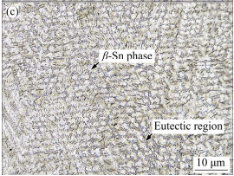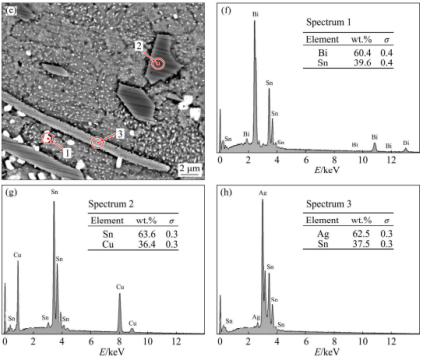Effects of Bismuth Doping on SAC305-xBi Medium-Temperature Solder Paste

https://en.szfitech.com/
Effects of Bismuth Doping on SAC305-xBi Medium-Temperature Solder Paste
Medium-temperature SAC305 solder paste was developed to replace Sn63Bi37 leaded solder paste. Although the melting point of SAC305 solder paste is slightly higher than that of Sn63Bi37 solder paste, its mechanical strength is roughly equivalent to that of Sn63Bi37 solder paste. Therefore, SAC305 has become one of the most common lead-free solder pastes. In order to further reduce the melting point of SAC305, some scholars have studied the doping method. It was found that Bi additive can reduce the melting point of the solder pastes. After a lot of certification, it was found that Bi doping less than or equal to 2wt% can reduce the solder melting point and enhance the strength of solder joints.
Varied Bi addition has different effects on the microstructure and strength of solder joints. In order to verify the optimal Bi doping amount, CHANTARAMANEE and SUNGKHAPHAPHITOON (2021) divided SAC305 solder pastes into three groups for testing, including no Bi addition, 1wt% Bi addition and 2wt% Bi addition. The observation of the solder joints after the copper plate test was conducted.
Table 1. Composition of SAC305-xBi solder paste.
SAC305-xBi Microstructure
β- Sn phase and eutectic region can be observed from the microstructure of SAC305 alloy. The main composition of the eutectic region is intermetallic compound (IMC), including Cu6Sn5 and Ag3Sn. In addition, it can be found that the microstructure of the alloy is refined if doping Bi. The reason is that Bi can reduce the undercooling of solder and accelerate the nucleation of grains. An interesting phenomenon is that the microstructure of the SAC305 solder paste with 2wt% Bi addition has Bi atoms dispersed in β- In Sn phase (Figure 2) because the solubility of Bi in Sn at room temperature is only 1wt%.


Figure 1. SAC305 alloy microstructure. (a) SAC305 (b) SAC305-1Bi; (c) SAC305-2Bi.
Figure 2. SEM-EDS diagram of SAC305-2Bi alloy.
The thickness of IMC layers is closely related to the fracture mechanism of the solder joints. The formation of IMC will increase the brittleness of solder joints. Conventional SAC305 solder paste will generate large amounts of Cu6Sn5 and Cu3Sn when reflow soldering and aging time are long. CHANTARAMANEE and SUNGKHAPHAPHITOON conducted reflow soldering for SAC305 solder paste (250 ℃, 2min), and they found that 2wt% Bi doping can significantly reduce the IMC thickness. The doping of Bi can reduce the solubility of Cu, slowing down the interface reaction between Cu and Sn. Thus, the growth rate of IMCs decreases.
Table 2. IMC Thickness of SAC305 Solder Joints.
SAC305 melting point change
The melting point of Bi is relatively low. After adding Bi, the melting point of the solder paste will be reduced to a certain extent. Sn in the solder will react with Bi to form new bonds. The atoms in the crystal structure are more easily displaced, reducing the solder melting point.
Table 3. Melting point change of SAC305 alloy. Tm: peak temperature; Tonset: solidus temperature; Tend: liquidus phase temperature.
Change in solder joint strength
Figure 3 shows that if it was without Bi doping, the ultimate tensile strength (UTS) of SAC305 was only about 36MPa. In the contrast, the ultimate tensile strength was significantly increased after Bi was doped, which benefited from the refinement of the microstructure by Bi doping. It can be seen that the addition of 2wt% Bi can maximize the tensile strength. At this time, the fracture mode of the solder joint is a ductile fracture. However, the elongation (EL) of solder pastes with Bi additions decreases. If a high amount of Bi is added, like more than 5wt%, the precipitated Bi will increase the brittleness of the solder joints, significantly reducing the ductility. The fracture mode of the solder paste shifts from ductile fracture to brittle fracture.

Figure 3. Ultimate tensile strength and elongation of SAC305 solder joints.
Reference
CHANTARAMANEE, S. & SUNGKHAPHAITOON, P. (2021). “Influence of bismuth on microstructure, thermal properties, mechanical performance, and interfacial behavior of SAC305−xBi/Cu solder joints”.











 Back to list
Back to list



